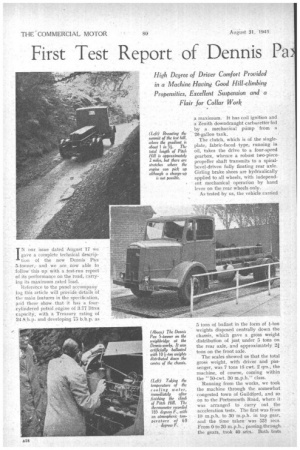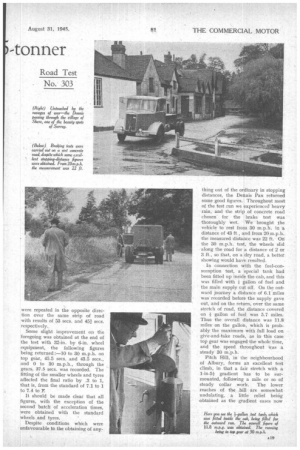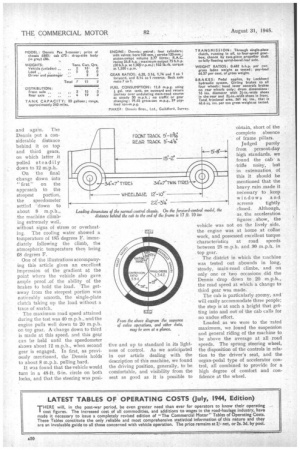First Test Report of Dennis Pa -tonner
Page 20

Page 21

Page 22

If you've noticed an error in this article please click here to report it so we can fix it.
i/ N our issue dated August 17 we gave a complete technical description of the new Dennis Pax 5-tormer, and we are now able to follow this up with a test-run report of its performance on the road, carrying its maximum rated load. .
Reference to the panel accompany ing this article will provide .details Of the main features in the specification, and -these show that it has a fourrcylindered petrol engine of 377 litres capa.citY; with :a Treasury rating of .24.8,11.p. and developing 75 b.h,p. as
a maximum. It has coil ignition and a Zenith downdraught carburetter fed by a mechanical pimp from a 20-gallon tank. .
The clutch, which is of the singleplate, fabric-faced type, running in oil, takes the drive to a four-speed gearbox, whence a robust two-piece propeller shaft transmits to a spiralbevel-driven fully floating rear axle. Girling brake shoes are hydraulically applied to all wheels, with independent Mechanical operation by hand lever on the rear wheels only.
As tested by us, the vehicle carried 5 tons of ballast in the form of 1ton weights disposed centrally down the chassis, which gave a gross weight distribution of just under 5 tons on the rear axle, and approximately 2/ tons on the front axle.
The scales showed us that the total gross weight, with driver and passenger, was 7 tons 15 cwt. 2 qrs., the machine, of course, coming within the 50-cwt. 30 m.p.h." class, Running from the works, we took the machine through the somewhat congested town of Guildford, and so on to the Portsmouth Road, where it was arranged to Carry out the acceleration tests. The first was from 10 m.p.h. to 30 m.p.h. in top gear, and the time taken was 531 secs. From 0 to 30 m.p.h., passing. through the gears, took 40 secs. Both tests were repeated in the opposite direction over the same strip of road with results of 53 secs. and 45; secs. respectively.
Some slight improvement on the foregoing was obtained at the end of the test with 32-in. by 6-in, wheel equipment, the following figures being returned :-10 to 30 m.p.h. on top gear, 45.5 secs. and 43.5 secs., and 0 to 30 m.p.h., through the gears, 37.5 secs, was recorded. The fitting of the smaller wheels and tyres affected the final ratio by .3 to 1, that is, from the standard of 7.1 to 1 to 7.4 to Ir.
It should be made clear that all figures, with the exception of the second batch of acceleration times, were obtained with the standard wheels and tyres.
Despite conditions which were unfavourable to the obtaining of any thing out of the ordinary in stopping distances, the Dennis Pax returned some good figures. Throughout most of the test run we experienced heavy rain, and the strip of concrete road chosen" for the brake test was thoroughly wet. We brought the vehicle to rest from 30 m.p.h. in a distance of 43 ft, and from 20 m.p.h. the measured distance was 22 ft. On the 30 m.p.h. test, the wheels slid along the road for a distance of 2 or 3 ft., so that, on a dry road, a better showing would have resulted.
In connection with the fuel-consutnption test, a special tank had been fitted up inside the cab, and this was filled with gallon of fuel and the main supply cut off. On the outward journey a distance of 6.1 miles was recorded before the supply gave out, and on the return, over the same stretch of road, the distance covered on I gallon of fuel was 5.7 miles. Thus the overall distance was 11.8 miles on the gallon, which is probably the maximum with full load on give-and-take roads, as in this case top gear was engaged the whole time, and the speed throughout was a steady 30 m.'p.h.
Pitch Hill, in the neighbourhood of Albury, forms an excellent test climb, in that a fair stretch with a 1-in-5-1 gradient has to be surmounted, following a mile or so of steady collar .work. The lower reaches of the ,hill are somewhat undulating, a little relief being obtained as the gradient eases now and again. The Dennis put a considerable distauce behind it on top and third gears, on which latter it pulled steadily down to 12 m.p.h.
On the final change down into 'first" on the approach to the
steepest portion, the speedometer settled --down to about 8 m.p.h., the machine climbing extremely well, without signs of stress or overheating. The cooling water showed a temperature of 185 degrees F. immediately following the climb, the atmospheric temperature then being 68 degrees F.
One of the illustrations accompanying this article gives an excellent impression of the gradient at the point where the vehicle also gave ample proof -of the ability of the brakes to bold the load. The getaway from the steepest portion was noticeably smooth, the single-plate clutch taking up the load Ixithoet a trace of snatch.
The maximum road speed attained during the test was 40 m.p.h., and the engine pulls well down to 20 m.p.h. on top gear. A.change down to third is made at this speed, and this gear can be held until the speedometer shows about 12 m.p.h., when second gear is engaged. In first, as previously mentioned, the 'Dennis holds to about 8 m.p.h. pulling hard.
It was found that the vehicle would turn in a 48-ft. 0-in, circle on both locks, and that the steering was posi obtain, short of the complete absence of frame pillars.
Judged purely from present-day high standards, we found the . cab a -trifle noisy, but in extenuation of this it should be mentioned that the heavy rain made it necessary to keep windows and screens tightly closed. Although, as. the acceleration figures . show, the vehicle was not on the lively side, the engine was at borne at collar work, and possessed excellent torque characteristics at road speeds between 25 m.p.h. and 30 m.p.h. in top gear.
The district in which the machine was tested out abounds in long, steady, main-road climbs, and on only one or two occasions did the Dennis drop down to 20 m.p.h., the road speed at which a change to third gear was made.
The cab is particularly roomy, and will easily accommodate three people; the step is at such a height that getting into and out of the cab calls for no undue effort.
Loaded. as we were to the rated maximum, we found the suspension and general riding of the machine to be above the average at all road speeds. The sprung steering wheel, the disposition of the controls in relation to the driver's seat, and the organ-pedal type of accelerator control, all combined to provide for a high degree of comfort and confidence at the wheel.




















































